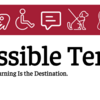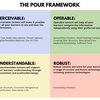Accessibility is about care and compassion for our students and commitment to an inclusive, welcoming environment for learning. It’s about proactive, prepared teaching. Rather than scrambling to make your course materials accessible when you receive an accommodation letter, designing a course that is accessible sends a powerful message to students that we know that access is important and we take action to ensure an inclusive and equitable environment for all students. We are required to meet the new ADA requirements described below, but we know as faculty that offering accessible courses is just the right thing to do. Accessible Temple is a university-wide initiative to ensure that accessibility is a reality at Temple.
The Mission of Accessible Temple:
Temple’s commitment to opportunity, access, and engagement is centered in the learning and working experiences we create and implement for the Temple community. By integrating the latest accessibility standards, we support all students to reach their full potential, uphold our mission of excellence in education, and provide a welcoming environment for those who work at and visit Temple.
The Goals of Accessible Temple are:
- to proactively develop a culture of inclusion that aligns with Temple’s core values of diversity and inclusivity;
- to ensure a welcoming environment that fosters a sense of belonging and allows everyone to feel they are a part of the Temple family; and to ensure compliance with the new ADA Web Content Accessibility Guidelines (WCAG) 2.1 by the deadline of April 2026.


